Hanhart Pioneer Mark I Reviewed

Pilot watches connect us with the freedom of the skies where wind and cloud are a world unto themselves. Pilot watches also look cool. As tool watches, they are designed for the function of aeronautical navigation, making them stalwart performers.
Inspiring, good looking and dependable; pilot watches are a popular choice, and the Hanhart Pioneer Mark I would be an excellent purchase. Leather flight jacket is optional.

When a song from my childhood comes on the radio, all kinds of memories flood my consciousness and take me to a time remembered. When a song before my time plays, possibly on a Victrola, I visualize another time altogether. Combine the World War II photos of crisp uniforms, pinup girls and sleek air machines with a watch, and I connect with a bygone age.
The Hanhart Pioneer Mark I is a repristination of the Luftwaffe’s legendary 1938 Flieger Chronograph, which entered compulsory service in a misguided age of conflict, but also an age of aviation prowess. Hanhart’s Pioneer Mark I is a journey into the past, and the ticking of the watch is music to my ears.
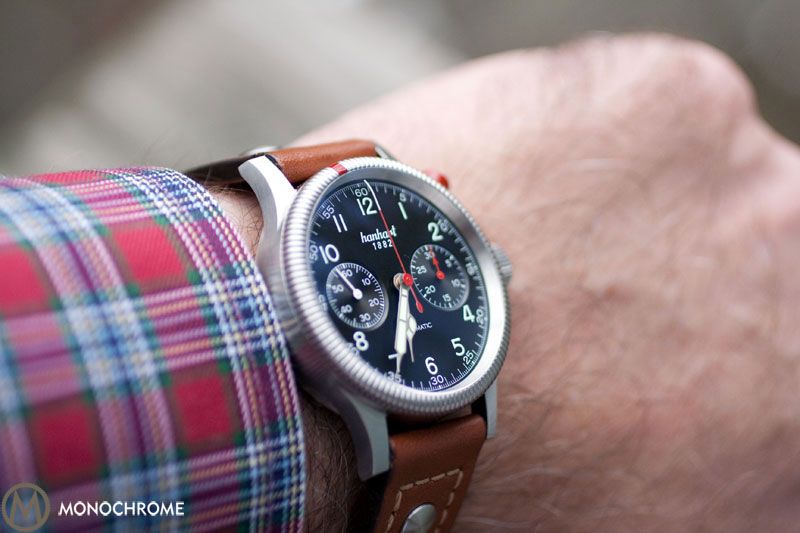
Overall Appearance
Hanharts are known for their red button chronograph pushers, a feature begun in 1938. Sitting solitary above two o’clock, The Pioneer Mark I has only one pusher instead of the customary two chronograph pushers, earning it the title of a mono-pusher. The red button’s origin is part of Hanhart lore told from the pilot’s point of view:
He placed a kiss lovingly on her brow as she slept before quietly leaving the apartment. As he looked at his Hanhart watch in the hangar, a smile flitted over his lips: she had painted the button with her red nail varnish so that he would think of her always and return safe and sound…
This watch exudes the pilot mystique.
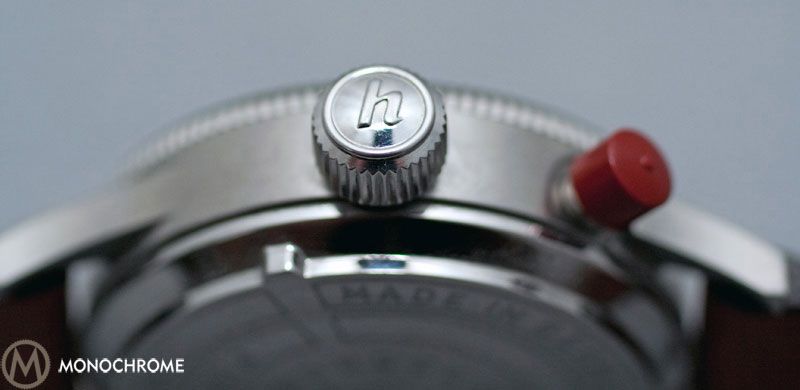
The Hanhart company has developed a reputation not only for accurate watches, but also stop watches. When the company discontinued watch production in 1962, their stopwatch manufacture continued. The nineties ushered in a rediscovery of traditional watch making, but the company still produces a prodigious amount of stopwatches. The mono-pusher looks and acts like a stopwatch.
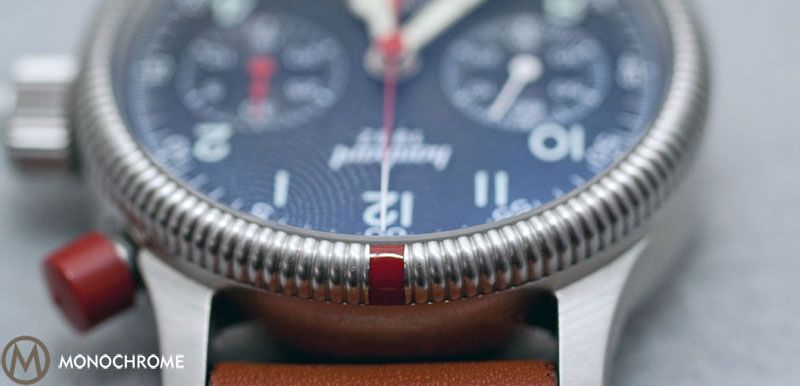
Red signifies all the chronographic functions, distinguishing them from normal time-telling; the 30 minute sub-dial hand is red, and the large seconds hand is red (with a white tip). Lastly, the marker on the fluted bezel is a plain red stripe. You notice the red. This contrasting bright color exists to aid visibility, and this is one of the easiest dials to read, hands down.

I’ve never thought of a pilot watch as a fashion watch and generally eschew the term, but it applies here in a good sense. The black dial, the white Mercedes hands, and the red chronographic functions make for one stylish watch. When you pursue function with German precision, you invariably get style.
Features
My favorite feature is the slip-proof bezel. Turning it feels like a skater gliding over ice, a feeling more to be experienced than described. For all the effortless movement, the bezel stays firmly in place. Because only one red stripe marks the bezel, the bezel can be used as a count-down or count-up bezel. I find this versatility appealing and distinctive.
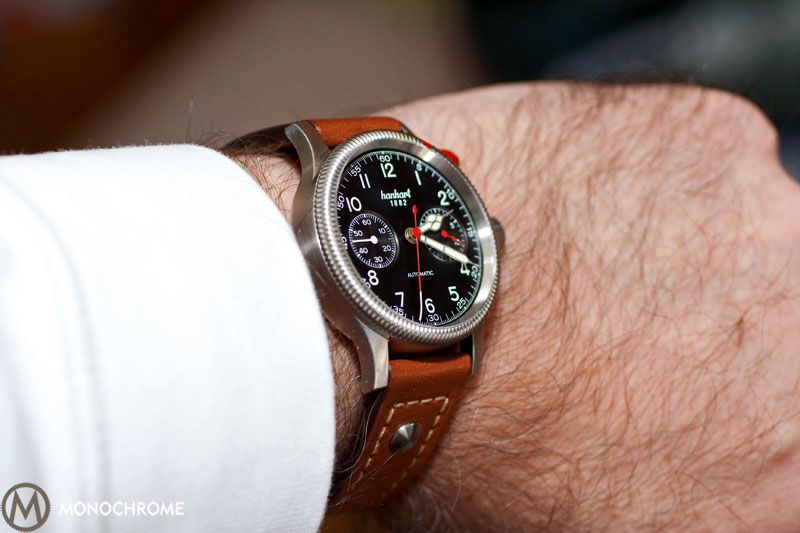
This watch exists to measure short intervals of time. In the old schoolhouse formula, rate times time equals distance (RxT=D), Hanhart has the time covered, which is how the watch helps a pilot to navigate. Being a mono-pusher, a throwback design, means the watch functions a bit differently than your typical chronograph. The functional series of start, stop and reset is followed sequentially with each press of the red button, without the option to restart before resetting. Given that the watch uses a Valjoux 7753, mono-pusher functionality meant a slight redesign of the caliber.
Dial/Hands
A standout for the Pioneer Mark I is its lume. The numerals have a subdued lume, but the lume on the hands is very bright. The Super-LumiNova aids visibility in variable light conditions, allowing a quick glance to the dial.
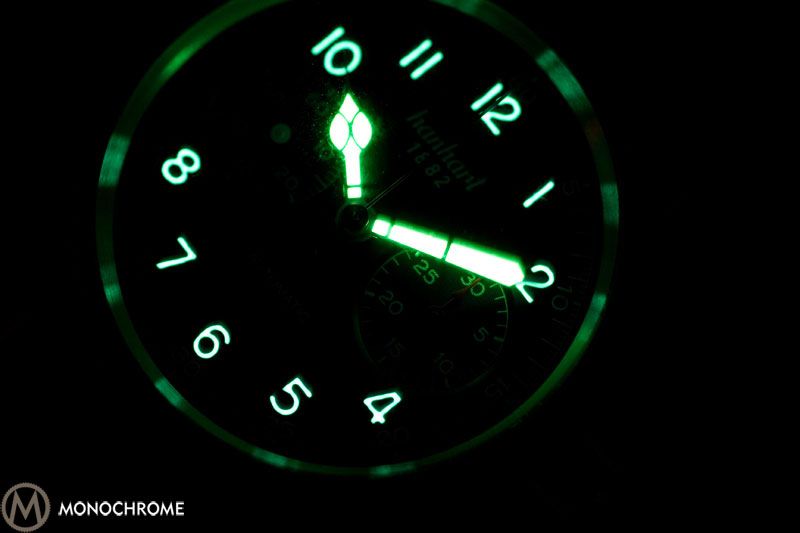
Vintage style Mercedes hands meander around the dial. They, along with the small seconds hand, are white in distinction to the red chronographic functions. The minute and hour hands end in a fine, needle-like point with the minute hand fitting over the chapter ring. The chronograph’s seconds hand (red with white tip) extends over the chapter ring and seems to just touch the inner case side. The fit of these larger hands with the chapter ring allows a precise time measurement.
The bicompax dial layout has the chronograph sub-dial on the right and the small seconds on the left. Therefore, the chronograph’s dial is closest to the pusher, which subdivides the dial, left and right, by function.
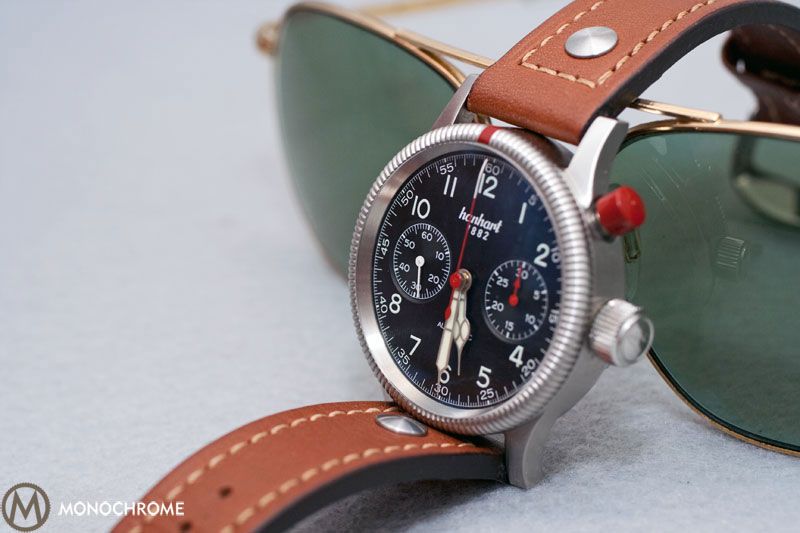
Case/Strap
Though a see-through case back is missing, there is much to see when you turn the watch over. The screwed-down case back is secured by the case key, which fits to the three extensions protruding slightly from the case edge. When viewing the case back, you see that the notches extend as part of a propeller graphic. The circular rings around the three propeller blades convey a sense of motion, encircling an engraved “h” as well as other information. The entire watch case is brushed stainless steel except for the crown tip and the polished band along the case’s bottom edge, which is visible upon turning the watch over. This little touch adds to the case back impression.

Returning to the familiar front side, the coin-edged, fluted bezel and crown pair well. Hanhart raises the red pusher high above the crown, a Hanhart modification for ease of use. The pusher sits as close to the lug as possible.
The lugs extended seamlessly from the case and angle slightly downward. Attached is a typical pilot strap, complete with rivets and white contrast stitching. The strap is thick and comfortable on the wrist.
Movement
As mentioned, the Valjoux 7753 required a slight modification. Hanhart shares, “The crank which sits directly beneath the button that would normally be positioned at 4 o’clock has no function. A large shift lever is therefore responsible for the third strike on the chronograph cam. This cam has also been modified by Hanhart so that it has an additional tooth on its lowest level. The shift lever can thus control not two, but three positions.” The movement is very noticeable when using the reset feature or the third push. With the depression of the red pusher, the large seconds hand tended to overshoot twelve o’clock, but snapped into place upon release of the button. The button has a very firm click, and with a quick push, this idiosyncrasy goes unnoticed.
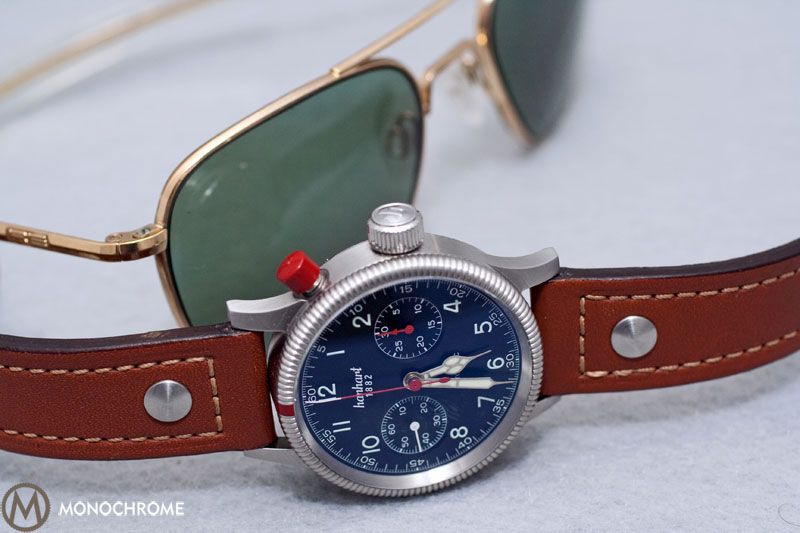
Turning the crown creates a guttural purr, and it rolls as smooth as glass. Without a screw-down feature, winding is immediate, and the crown’s larger size means, just like the pilots of yesteryear, you can wind it with gloves.
The Verdict: Pros and Cons
Pro:
- The traditional Hanhart Red Button!!!
- Contrasting color scheme and overall good looks
- Dial is one of the easiest to read
- Effortless slip-proof bezel
- Purring crown
- Bright lume
- Traditional strap styling with rivets and contrast stitching
- The price is a bargain
Con:
- The play in resetting the watch. I would like the minute hand to snap directly to twelve o’clock without overcompensation.
- This is a matter of taste and loses something of the retro-design, but I prefer a quick release clasp instead of a traditional buckle.
HANHART PIONEER Mk I
- Movement: HAN3601 modified automatic chronograph movement (bicompax), based on the Valjoux 7753 calibre, with increased crown-to-button spacing and single-button conversion; 28,800 vibrations per hour, 4 Hz; 27 jewels; power reserve of min. 42 hours
- Functions: Small seconds at 9 o’clock, 30-minutes counter at 3 o‘clock
- Case: Stainless steel; red button; fluted, bidirectional rotating bezel with red marking; convex, internally anti-reflective sapphire glass; screwed-down case back; diameter 40 mm, height 15 mm; water-resistant to 10 bar/100 m
- Dial: Black or Off-white; Super-LumiNova®-coated, luminous numerals and hands
- Strap: Brown or black calfskin with riveting; pin buckle made from stainless steel
MSRP: $4150
Here you can visit the Hanhart website.
Article and photos by Max E. Reddick, contributing writer for Monochrome Watches.



